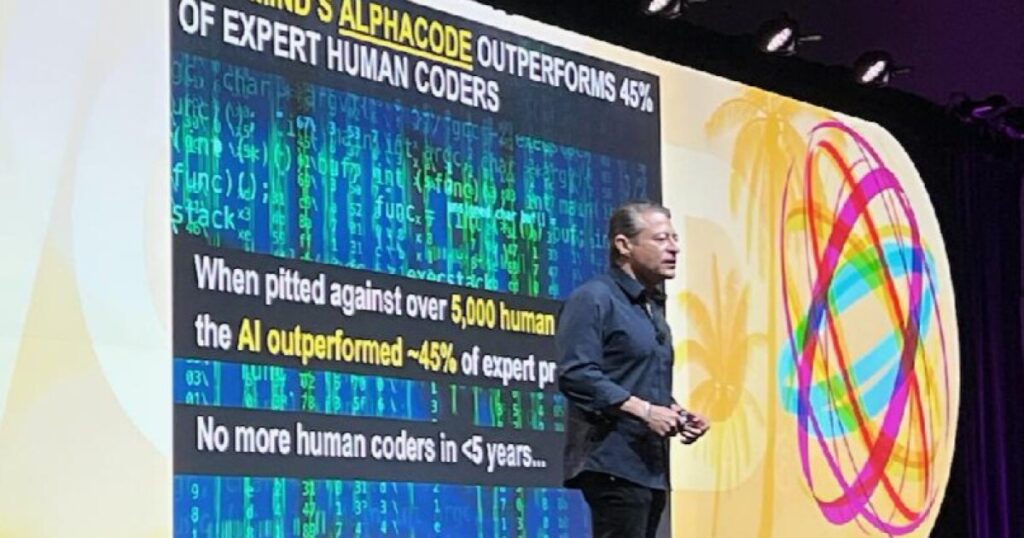Predicting the future for risk management

The 2024 RISKWORLD event in San Diego, Calif., drew over 10,000 risk managers and other insurance professionals from more than 60 countries, as the organization celebrated its 25th anniversary this year.
Peter Diamandis, MD, founder and executive chairman of the XPRIZE Foundation, which focuses on creating and managing large-scale incentive competitions focused on multiple areas, delivered the opening keynote. The New York Times bestselling author is fond of saying, “the best way to predict the future is to create it yourself,” and his keynote, “Exponential World Ahead: The Future is Faster than you Think,” highlighted how that possibility is becoming a reality.
“The day before something is a breakthrough, it is a crazy idea,” said Diamandis, as he provided insights on several meta-trends he sees affecting the insurance industry in the next six years.
1. Increasing abundance in energy — Solar energy is at an all-time low in terms of cost. Battery storage is doubling year-over-year and 13 gigafactories have already been built. Automakers plan to build 54 million electric vehicles in 2030, representing more than 50% of the autos on the road.
2. Ubiquitous comms & sensors — Diamandis said we have the ability to know anything, anytime, anywhere, and everything everywhere is connected in some way. SpaceX is doubling the number of satellites in orbit and every square meter on the planet can be connected. Today’s 5G networks will soon become 6G, which has a download speed that is 100 times faster than 5G. “We are blanketing the world in sensors with 100,000 satellites for space-based comms, there is a new generation of drones flying, and eventually a new generation of flying cars,” he shared. “The data is there and we’re about to head to a world with trillions of sensors.”
3. Growth of AI — AI is 68 years old and access to data is doubling every two years. “A massive amount of data is available and it’s our data,” said Diamandis. “AI is our progeny.” The cost of training these models is dropping and the amount of capital available to invest in it is growing. “We can’t ignore this topic — it is at the center of everything and we have to be having these conversations.”
Diamandis went on to say that there will be two types of companies by the end of this decade — those who fully utilize AI and those who are out of business. “It is your single greatest partner,” he shared as he encouraged the audience to explore and play with AI.
While ChatGPT is growing faster than ever, Diamandis predicted that something else will beat it in terms of growth in the next two years. While Ray Kurzweil predicted that AI will achieve human levels of intelligence by 2029, Elan Musk believes it could happen as soon as 2025. The question then becomes, what happens when AI is smarter than we are?
AI continues to evolve and is now able to create a video of an individual from a still photo. Deepfakes that were once easy to identify are now indistinguishable from real people.
AI will also transform healthcare, given its ability to diagnose cases in just minutes based on available information, and could be used to identify issues such as Alzheimer’s, dementia and autism much earlier.
While many people are worried that AI will take their jobs, Elan Musk is building an Optimus robot that will be able to build and create products, making the need for people to handle more mundane tasks unnecessary. Musk’s goal is to build more robots than cars at some point in the near future.
4. Longevity & healthspan – Imagine being able to live to be 100 or 150 years old. Diamandis says we are in the midst of a healthspan revolution. Epigenetics will be able to affect how people look and which genes are turned on and which are off in an individual. “We are seeing billions of dollars going into extending your healthspan with $5.2 billion invested in 130 lifespan technologies,” he said. Vaccines for cancer, Alzheimer’s and to prevent strokes are in development and the human genome can be sequenced in just seven hours, which could change or cure genetic diseases within a family. Diamandis also said it will be possible to take stem cells from an individual and create an organ such as a liver or kidney for an individual who requires a transplant, only the organ would be a part of the individual with less chance of rejection.
As a futurist focused on the possibilities surrounding AI and other technologies, Diamandis left many in the audience wondering about the implications of what he had shared. The practical questions such as how does living longer affect our work lives (and workers’ comp and health claims) or what happens if a physician relies on AI to diagnose a patient and the AI is wrong — will an E&O or malpractice insurance still cover him — are questions to be considered for another day, but the insurance industry shouldn’t wait too long to address them.



